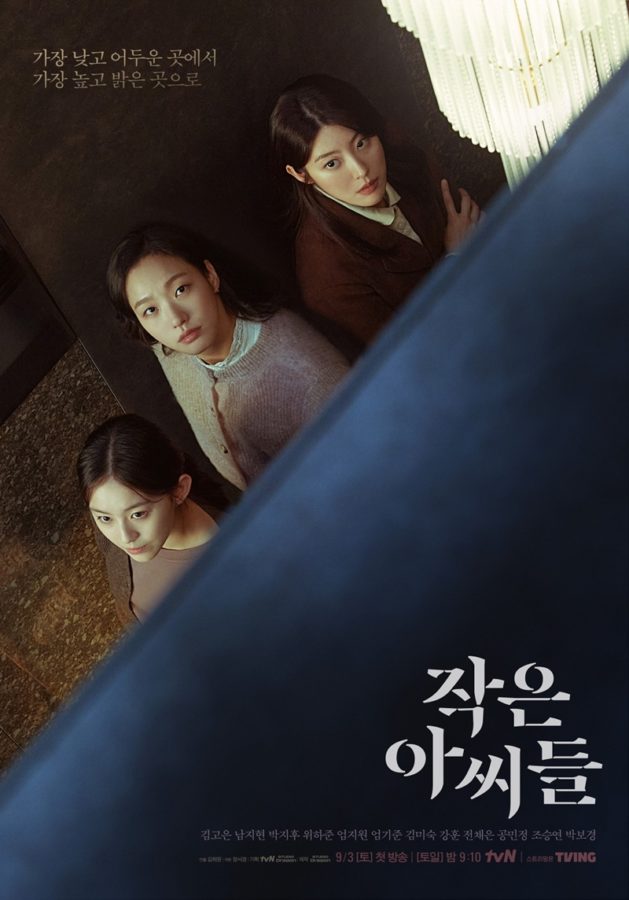“Little Women” thrills viewers with a fast-paced story of sisterhood
courtesy of tvN
“Little Women” puts a riveting, dramatic spin on Louisa May Alcott’s book of the same name.
November 1, 2022
Running from Sept. 3 to Oct. 9, Netflix’s “Little Women” is a dynamic take on Louisa May Alcott’s novel of the same name. Written by Chung Seo-Kyung and directed by Kim Hee-Won, the Korean drama is a suspenseful social commentary on the haunting effect poverty can have on one’s dreams and aspirations.
The show revolves around the story of the Oh sisters, In-Joo (Kim Go-eun), In-kyung (Nam Ji-hyun) and In-hye (Park Ji-hu), as their lives become tangled with Korea’s most influential family and a missing sum of 70 billion won. As the eldest, In-joo has faced poverty her entire life. Known as the upper-floor outcast at the finance company she works at, she believes that only money can protect her family. In-kyung, the middle sister, is a tenacious reporter at a news station who doesn’t want to give in to the appeal of money. She begins investigating a case involving Park Jae-sang (Uhm Ki-Joon), a powerful politician who is running for mayor of Seoul. The youngest, In-hye, is a talented artist attending a prestigious arts high school, and becomes close friends with Jae-sang’s daughter, Park Hyo-rin (Jeon Chae-eun). In-hye often feels burdened by her sisters’ love and wishes to stop feeling indebted toward her family.
The plot is set into motion with the death of Jin Hwa-young (Choo Ja-Hyun), In-joo’s coworker and fellow outcast. When In-joo discovers her late friend’s body hung in a closet and a large sum of money left by her friend under In-joo’s name, the lives of the Oh sisters and the Park family start to inexplicably and continuously intersect.
Despite being inspired by Alcott’s novel, the drama follows its plot very loosely. Rather than depicting a coming-of age-story, “Little Women” tells the story of murder, money, and a decades-old conspiracy. It incorporates nail-biting suspense and twists and turns that keep the viewers intrigued to find out what the characters will do next. The plot entices the viewer because of the way it gradually unfolds — introducing each piece of the puzzle separately and allowing the mystery to keep building.
“Little Women” also stands out because it is largely female-driven, something that is not usually seen in K-dramas of its genre. Rather than being pushed into the background as love interests of minor characters, the women of “Little Women” take initiative, and in some cases, even pull the strings. The Oh sisters are resilient and inspiring, but are not without their share of character flaws and inner conflicts. For instance, In-joo might initially come off as greedy or desperate, and In-hye’s first impression might be that of an ungrateful teenager. However, as the story develops, each character becomes increasingly complex.
“When I create a character, I think about what he or she holds as a purpose in life. I focus on what their motivations are in their actions,” Screenwriter Chung Seo-Kyung said. “I realized that I’ve never put any likable features that viewers would like in my scripts, [but] despite the characters’ flaws, I want people to come to love them.” And lovable they are — their rich characterizations and interesting developments allows the viewers to form an authentic connection with the characters.
The show also forgoes k-drama-typical romance to explore strong familial and platonic relationships, especially in sisterhood. The Oh parents are absent for the majority of the drama, turning the attention to how the lack of parental support leads the sisters to form a close bond. The three of them are fiercely protective of each other in their own ways, and it can be seen time and again that this is one of their primary motivations. When Hyo-rin suffers from panic attacks due to her parents’ constant conflict, In-hye is there to support her by giving Hyo-rin the care that her parents had failed to give her. The two of them are endlessly supportive of each other, and those heartwarming moments are like gems in the otherwise-bleak plot. On the other hand, In-joo and Hwa-young’s bond is really what propels the storyline. In-joo’s fierce desire to seek justice and get to the bottom of her friend’s death, no matter what happens, is foundational to the drama.
Underneath all the adventure and mystery, “Little Women” is a compelling study on how sisterhood withstands the obstacles that come with poverty, class, and power. The show forces viewers to consider the question “just how far would you go for money?” And, for many of the characters, the answer is unclear, making the show intriguing. The fine line between what is and isn’t moral is blurred and challenges the audience to see the world through uncommon perspectives.
This comes to life under the direction of Kim Hee-Won, who cleverly uses recurring symbols for important themes. Shoes, especially high heels, represent wealth and ambition — especially for In-joo, whose problems start when she trades out her cheap flats for a pair of pricey heels gifted to her by Hwa-young. The blue orchids that appear at every crime scene have a sinister connotation to them for representing inescapable power and corruption. Visually, “Little Women” is stunning, each carefully-chosen element adding to its intricacy.
“Little Women” is the perfect watch for people who enjoy the thrill of solving mysteries along with the characters. Because of this, the show demands a lot of attention to detail from the viewer. The drama moves quickly, and each action-packed episode is filled with a multitude of characters, names, references, and events all happening in parallel. Added to the tangled character relations and the amount of economic and political theory that is tied into the plot, it’s easy to find yourself lost or overwhelmed with everything going on.
But as the show progresses, all the information starts to connect and becomes easier to digest. With twelve almost-hour-long episodes, the show has a magnetic appeal that keeps you invested in what is going to happen next. For those who enjoyed “Little Women,” similar shows include “Big Mouth,” a recent k-drama that involves an incompetent lawyer digging into a conspiracy among the upper-class and “The Penthouse,” a drama indulging in a world of murder, drama, adultery and disguise in the lives of Korea’s most elite.
The show simply stands out from other k-dramas of its genre. Through excellent storytelling, haunting visuals, and compelling characters, “Little Women” delves deep into the social issues woven into the fabric of society. Though it is somewhat of a wild ride, the drama has proved itself to be an original, exhilarating show that emphasizes sisterhood and its power to overcome difficulties.







